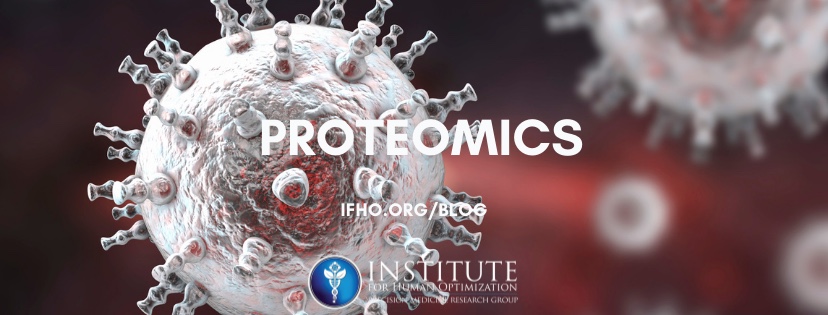PROTEOMICS: THE TRANSLATION OF OUR BLUEPRINT
The technology surrounding proteomics has evolved in recent years providing promising new directions to study for future clinical application and in the pursuit of precision medicine. Moreover, advanced proteomic technology has allowed researchers the platform to improve our understanding of biology.
. . .
What is proteomics?
Proteomics refers to the study of proteomes. Proteomes are the entire set of proteins that are expressed by an organism. Proteins are responsible for the function of the cells. Since protein is the main element in food, and with proteins being fundamental to cellular function, proteomic technology can successfully identify the protein content of food, assessing their protein biomarker, and how they change during their production.
Application of Proteomics in Medicine
Currently, proteomics is being used extensively for biomarker discovery. Biomarkers is defined by the National Institute of Health Biomarkers Definitions Working Group as “a characteristic that is objectively measured and evaluated as an indicator of normal biological processes, pathogenic processes, or pharmacologic responses to a therapeutic intervention.” It is a means to a facet of health.
With proteomic technology, we look at proteomic expression to identify protein biomarkers of disease. Biomarkers can be categorized as diagnostic, prognostic, predictive or predisposition biomarkers.
- Diagnostic: Diagnostic biomarkers are used to confirm that an individual has the presence of a specific disease or health disorder.
- Prognostic: A prognostic biomarker can showcase how disease will progress when an individual has been diagnosed with a specific disease or health disorder.
- Predictive: A predictive biomarker is used by clinicians to help determine how well a treatment will work for the individual.
- Predisposition: A genetic predisposition biomarker is a biomarker that indicates a susceptibility for that individual to develop a specific disease or heath disorder.
Techniques used in Proteomics
Most approaches in proteomic analysis use a bottom-up or top-down approach.
Bottom-up proteomics: is also considered a peptide-level approach as samples are characterized by their amino acid sequences prior to analyzing.
Top-Down proteomics: Unlike bottom-up that digests proteins into peptide sequences, Top-down proteomics analyzes proteins intact. By bypassing the protein digestion step this method is considered less time consuming and simpler.
What are some of the techniques used for proteomic analysis?
- Ionization: There are two main methods used for the ionization of protein. One is Electrospray Ionization (ESI) is a technique where a high voltage is applied to a liquid to create an aerosol. The other is the matrix-assisted laser desorption ionization (MALDI) that uses a laser energy absorbing matrix to create ions from large molecules with minimal fragmentation. While different techniques are both used in the proteomic analysis by looking at how proteins and peptides react.
- Triple Quadrupole: Quadrupole analyzers use alternating radio frequency as a quantitative method for targeted proteomics. https://pubmed.ncbi.nlm.nih.gov/22409554/
- Analyte Quantitation Methods: Analyte quantitative methods are techniques used to determine the number of proteins in a sample as well as differences between biological samples. This is used to compare samples between healthy and disease patients as well as to identify and quantify changes in individual proteins.
Clinical Applications
Proteomics is used in a host of clinical scenarios from common disease diagnosis and management to the diagnosis of cancer. These biomarkers are used to help assess clinical responses to medical interventions and gauge the severity of illness. For example, hs-CRP is used to assess cardiovascular inflammation. When these protein is elevated in circulation its associated with an increased risk for heart disease and stroke in people who don’t already have it.
Future of Healthcare
This Omics in medicine is important as it improves our understanding of biology by allowing us insight into the vitality of cells. As the vitality of a cell changes, these changes are visible at the proteomic level. Techniques in the proteomic analysis are seeing changes in protein profiles being a future predictive diagnostic tool to assess disease. While technology is advancing, the use of proteomics in healthcare is still very much considered in the discovery phase as full integration is still under works. While we have not reached full clinical utility, the benefits and potential uses are promising with technology rapidly evolving. As medicine continues to advance, the use of proteomics will be a part of precision, personalized approach to medicine.
The Institute for Human Optimization is committed to helping you create a personalized plan for living your longest, healthiest life possible. My team and I leverage the most cutting-edge advances in genetic testing, nutritional analysis, and functional medicine to get to the root biological imbalances that cause aging.
We know that each person is truly unique. From DNA to iris, we all possess a blueprint that is genetically inherited and environmentally influenced. By gaining a deeper appreciation for the person on a molecular level and addressing the root causes driving disease, we can help promote optimized health through our unique scientific, N of 1, approach to individualized care.
The Institute for Human Optimization provides the most comprehensive, data-driven, personalized approach to wellness. It is:
· Predictive – We use genomics and advanced biomarker testing to risk stratification and empowerment.
· Personalized – We use data-driven health information to curate actionable change for disease mitigation and prevention.
· Preventive – We utilize highly individualized programs tailored to your unique genomic blueprint.
· Participatory – We empower engagement in personal choices, which allows for improved outcomes and enhanced results.
I am so excited about the possibility to support you on this cutting-edge journey to extend your lifespan AND your healthspan. Click here to schedule Your Longevity Equation Epigenetic Consult! Can’t wait to meet you!








Leave a Reply
Want to join the discussion?Feel free to contribute!